When the folks at a large fruit and vegetable processor decided to review their manual cleaning processes, they discovered the need to incorporate automated cleaning and sanitizing equipment to improve cleaning results, generate labor savings and enhance safety procedures.
That is when the Sani-Matic SaniCab came into the picture, and here’s how it helped them greatly improve their cleaning and sanitation process.
Cleaning with Confidence
“We didn’t have a designated place for weigh scale bucket washing on the platform, so scale buckets were placed wherever we could find room to put them,” said the food processor’s Pouch Superintendent. “This meant we weren’t 100% sure everything was cleaned to our standards.”
“We came to Sani-Matic for their expertise in cleaning and sanitizing equipment. With the SaniCab’s custom-designed rack, you remove the weigh scales from the top of the scale system down and place them on the rack as you go. When you are done, you can visually see that absolutely everything is in the cabinet and washed.”
The Pouch Supervisor added that the process was also easier. “We have the rack and cart that we take right over to our scale system. We rinse the buckets and put them on the rack. Then we push the cart to the open washer and roll the rack inside. Everything is organized. Easy in and easy out. You get a thorough cleaning, every time.”
According to Sani-Matic Senior Product Development Manager Pete Barrie, the SaniCab washer and accompanying rack and transfer cart are designed to optimize parts placement, so the maximum soiled surface area is facing the spray patterns.
“The SaniCab rack is designed to meet our customer’s processes. Our customers provide us with drawings or the actual process parts they want cleaned so we can 3D model the parts and rack to ensure full spray coverage for effective cleaning,” said Barrie.
He added the rack with transfer cart also are easy to load and safely transport from the process equipment to the cabinet washer.
“Our transfer cart system allows the rack to enter the washer, while the cart itself remains outside of it,” stated Barrie. “This prevents contaminants found on the cart’s wheels from entering the system.”
Maximizing Output and Labor with Cleaning and Sanitizing Equipment
Implementing an automated cleaning process with the SaniCab enabled the fruit and vegetable processor to better use its people and technology resources, according to the company’s, Production Supervisor.
“We can get our sanitation done quicker with Sani-Matic’s cleaning and sanitizing equipment, reducing downtime and allowing us more time to run product,” he said. “Essentially, we now get a quicker turnaround when starting a new line. That means we can run later into a shift or start earlier the next day. One way or the other, we are increasing uptime.”
It also means the processor can maximize its personnel time. “Instead of taking two hours to wash scale buckets, our guys can move on to other equipment,” the Production Supervisor noted. “This further helps us increase uptime.”
Barrie added, “We are known for designing our equipment to provide sanitary, repeatable cleaning results; however, the significant labor savings realized when using the SaniCab is not as well known.”
“The SaniCab generates labor savings up to 75% when compared to manual cleaning, and reduces damage to expensive process parts that often occurs when using a manual process,” Barrie stated.
Enhancing Safety
The previous manual cleaning process at the processor required utilizing buckets, hoses, and water—15 feet off the ground. This process increased a chance for dropping and damaging weigh scale buckets and potential injuries to the team. They were looking for a solution to ensure a clean and safe environment.
“We solved a potential safety hazard,” the Production Supervisor said. “With hoses, water, and scale buckets that high, there is always potential to drop one.
Water Conservation
Both supervisors also commented on the company’s sustainability goals toward saving water and energy.
“We have a big corporate objective to reduce the amount of water used,” the Pouch Supervisor added. While it is difficult to obtain exact figures on water savings, he continued, “Standing on the top of the platform, spraying down scale buckets for two hours, as we did before – I’m sure we’re reducing our water usage.”
The SaniCab’s 17-gallon sump does result in water savings for customers affirmed Barrie.
“Completing the wash steps with 17 gallons per step, and reusing the water for the next cycle’s pre-rinse step, results in a four-step cycle—pre-rinse, detergent wash, mid-rinse, and a final water reuse rinse—and 51 gallons of water,” said Barrie. He added, “When comparing that to manual cleaning, you realize extensive water savings. For example, a standard washdown hose uses approximately six gallons of water per minute. When multiplied by two hours, that can equate to 720 gallons of water.”
Overall, the fruit and vegetable processor is pleased with the SaniCab performance and reliability. “We are so impressed with the thoroughness of the clean. The clean-up of the cabinet itself is convenient, too. The design of the cleaning and sanitizing equipment includes a screen and a conveyorized belt on the bottom of the washer, which makes removing large debris easy. It’s also easy to add detergent and sanitizing chemical,” stated the Production Supervisor. “To this point, everything has been very good. It’s worked well for us.”


